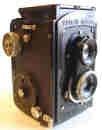
Bradac Bros. Companion
This is the second generation model. The lenses are coupled by string pulley. Originally named as the "Kamarad II", but translated for sale abroad as the "Companion".
Both lenses Meyer Trioplan 75mm f2.9
Compur shutter 1 - 1/250
Czechoslovakia c. 1937
|

Optikotechna Autoflex
This is the evolution of Bradac's Kamarad II, via the Optiflex, after the Optikotechna takeover. The lenses are still coupled by string. Note that it still bears the Bradac name.
Both lenses Meyer Trioplan 75mm f2.9
Compur shutter 1 - 1/250
Czechoslovakia c. 1938
|

Optikotechna Flexette
Very similar to the Autoflex, but with smaller lens set - presumably it was sold as a cheaper variant model in parallel
Both lenses Rodenstock Trinar 75mm f4.5
Prontor II shutter 1 - 1/150
Czechoslovakia c. 1938
|

Optikotechna Flexaret I
Cheaper (?) evolution of the Autoflex, still by Optikotechna, with own lenses. Lenses still coupled by string pulley.
Lenses Optikotechna Mirar 75mm f4.5
Compur shutter 1 - 1/250
Czechoslovakia c. 1939
|

Optikotechna Flexaret II Type 1
Depending on who you believe, Optikotechna merged into Meopta in 1945 or 1946. The early Flexaret II was produced by Optikotechna before the takeover. Gejza Dunay says "The original Flexaret II was manufactured by Optikotechna about 1946 and may be even earlier". The Type 1 has a flat viewfinder like the Flexaret I. The Type 2 is extremely rare (I've never seen one), with a side picture counter like the Optiflex and an unusual shutter housing said to be like the Zeiss Ikoflex III.
Lens Optikotechna Mirar 80mm f4.5
Prontor II shutter
Czechoslovakia c. 1945
|

Optikotechna Flexaret II Type 3
The type 3 was the last of the Flexaret II versions, and must have been made by Meopta. Interestingly, the factory was still putting Optikotechna's name on the lenses and finder top - the viewfinders with Optikotechna's name were probably used for several years after Optikotechna merged into Meopta. The Type 3 here looks like later Meopta Flexarets, which had the domed tops.
Lens Optikotechna Mirar 80mm f4.5
Prontor II shutter
Czechoslovakia c. 1947
|
.JPG)
Meopta Flexaret IIa
This was the first Meopta-named model, following the post-war business name change. It has the Meopta name on the hood and the lenses. Little else was changed from the previous model; it is safe to assume that resources were scarce in Czechoslovakia at this point.
Taking lens Meopta Mirar 80mm f4.5
Meopta Metax shutter 1 - 1/400
Czechoslovakia c. 1947-8
|

Meopta Flexaret III
The III and IIIa are the only Flexarets with crank winding - which was an unreliable attempt to emulate the Rolleiflex. The approach was a bit of a failure, because Meopta weren't able to invest sufficiently to get the necessary reliability in the crank mechanism.
Taking lens Meopta Mirar 80mm f3.5
Prontor SV shutter 1 - 1/300
Czechoslovakia c. 1948-50
|

Meopta Flexaret IIIa
The Flexaret IIIa is essentially similar to the III, but has a flash synchronisation shutter, with take off under the setting ring.
Taking lens Meopta Mirar 80mm f3.5
Prontor S shutter 1 - 1/300
Czechoslovakia c. 1948-50
|

Meopta Flexaret IV
Meopta abandoned the flawed crank film winding of the Flexaret III and went back to knob winding for relaibility.
Taking lens Meopta Belar 80mm f3.5
Prontor SVS shutter 1 - 1/400
Czechoslovakia c. 1950-57
|

Meopta Flexaret IVa
A variant of the Flexaret IV, which is able to use 35mm film. The sports finder has a small centre window for this.
Taking lens Meopta Belar 80mm f3.5
Prontor SVS shutter 1 - 1/400
Czechoslovakia c. 1953-57
|

Meopta Flexaret V
The Flexaret V is a cosmetic evolution of the IV. Main changes are more stripes on front and double-knob focus swivel.
Taking lens Meopta Belar 80mm f3.5
Prontor SVS shutter 1 - 1/400
Czechoslovakia c. 1958-61
|

Meopta Flexaret Va
The Va is a Flexaret V adapted with a separate rewind knob which permits 35mm film to be used, provided you can source the special adaptor/mask kit (not hard).
Taking lens Meopta Belar 80mm f3.5
Prontor SVS shutter 1 - 1/400
Czechoslovakia c. 1958-61
|
.JPG)
Meopta Flexaret VI
The first "Automat" model, with auto film position/number indicator and usually grey leatherette. Can take 35mm film with the special adaptor kit.
Taking lens Meopta Belar 80mm f3.5
Prontor SVS/Metax shutter 1 - 1/400
Czechoslovakia c. 1961-67
|

Meopta Flexaret Standard
The Standard is a simplified Flexaret VI, using red window for film positioning. It cannot take 35mm. Usually with black covering. Gejza Dunay reckons that the Flexaret Standard is the rarest of all the basic Flexaret types except for the Flexaret I and probably the Flexaret III. Stripped of the frills on the VI and VII models, it is very reliable without the automatic picture counter, which can break.
Taking lens Meopta Belar 80mm f3.5
Metax shutter 1 - 1/400
Czechoslovakia c. 1964
|
.jpg)
Flexaret Standard (silver)
The Flexaret Standard can have any of three names on the nameplate: Flexaret Standard (common), Flexaret (less common) or Flexaret S (extremely rare). The Standards were manufactured both with black and silver-grey leatherette (the VI and VII models only use the latter). This one is essentially the same as the previous Standard, but with silver leatherette and "Standard" on the nameplate
Taking lens Meopta Belar 80mm f3.5
Metax shutter 1 - 1/400
Czechoslovakia c. 1964
|

Meopta Flexaret VII
The last "Automat" model and the very last production Flexaret, still well-regarded as a photographic tool. The main change from the VI is a shutter upgrade. As far as I know, it was only made with the silver-grey leatherette covering. It can take 35mm film, with a special adaptor set available.
Taking lens Meopta Belar 80mm f3.5
Prestor RVS shutter 1 - 1/500
Czechoslovakia c. 1966-71
|




.jpg)
